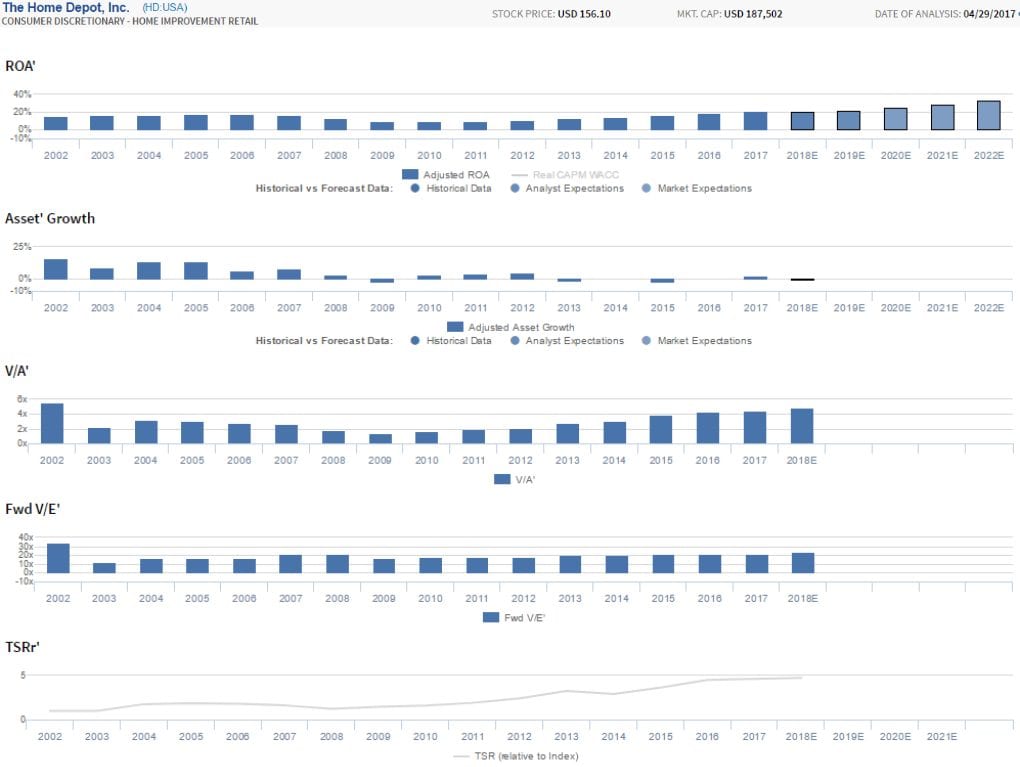Good versus Bad Free Cash Flows
Updated April 16, 2020
Can More Free Cash Flow Be a “Sell” Signal?
Home Depot (HD:USA) was a darling of the investing public from 1985 until 2001, with returns in excess of 20x the market over that period. In the era of the tech market and the internet boom, a home improvement retailer was one of the best performing stocks for a 16-year period.
During this time, Home Depot also seemed to break one of the cardinal rules of fundamental investing, exhibiting grossly negative free cash flow. When examining something as basic as total cash inflows less total cash outflows, year over year, it was clear that more cash was being invested than being generated. Aggressive growth in stores and inventory outpaced operating cash flows. The company posted negative free cash flows 15 out of 16 years. Yet, Home Depot consistently beat stock market returns by a wide margin.
Then, in 2001, Home Depot’s free cash flow turned wildly positive. It did not have as many growth opportunities, and cash flow from operations finally started to outpace new investment. Following years of negative free cash flow in the hundreds of millions, suddenly Home Depot generated well over $2.5 billion in positive free cash flow. What happened to the stock when this shift occurred? Home Depot had its worst stock performance ever.
Did the market take leave of its senses? Was this a “bubble” phenomenon? It begs the question as to how the market could seemingly punish stocks for their great free cash flow performance and reward them when free cash flows are grossly negative.
Free Cash Flows Tell a Story
Ask 10 finance experts to define free cash flows, and you get 10 different answers. This article, however, is focused on the commonality of free cash flow calculations, instead of the differences. Most seem to focus on the idea of “cash generated from the operations of the firm” minus “cash for maintaining and growing the business.” Essentially, cash created less cash used up. If any business invests more cash in itself than it generates over the long haul, there is a serious problem. But what constitutes “long?” It may be easy to miss the simple, yet decision-changing nuances.
Companies early in their life cycle naturally show negative free cash flows. Start-ups spend money in assets before they can generate a return off of them. Therefore, negative free cash flows result from investing at far greater rates than they are generating cash from operations. As long as the market believes free cash flow will eventually become positive enough to make up for it, negative free cash flows in the near term can be forgivable. How near is the near term?
For Home Depot, the early life cycle period, with highly negative free cash flows, lasted for 16 years, and from 1985 to 2000 the stock’s performance was fantastic. The market understood the issue well.
How Can Negative Free Cash Flow Be Positive?
All negative free cash flow companies are by no means good investment opportunities. But, having negative free cash flows is not necessarily a bad thing either. The key in understanding “good negative free cash flows” versus “bad negative free cash flows” is in examining returns and growth together.
Negative free cash flows must always be examined in the context of the rate of return and the rate of growth.
When a company turns from negative to positive free cash flows, this can generally mean one of two things. Either it has improved its return on assets (ROA) sufficiently to exceed its growth rates, or it has reduced the growth rate in the business well below its rate of return.
Home Depot is a classic example of the second situation. In the period of Home Depot’s exponential stock growth, it may have had negative cash flows, but this was due to its impressive growth rate. From 1985 to 2000, it grew gross investment below 20% in only four years. To put this in perspective, a consistent growth rate of 20% means a business will double in size in less than four years. As long as that growth in capital will realize returns above the cost of that capital, negative free cash flows can be a great sign for the business.
Home Depot was growing faster than this on an annual basis. On top of this impressive growth rate, Home Depot never had a Uniform ROA lower than 10%. Over that period Home Depot was spending all its cash on growing its high return business. Since 2001, it has not grown more than 25% in any year. Despite impressive, historically high Uniform ROAs, growth rates have subsided, as has the stock price. Newly positive free cash flows can signal less-than-expected growth rates and a disenchanted market.
When Growth Companies Stop Growing?
The key here, as is true with so many metrics, is that they cannot be observed in a static universe. Investors should also examine the underlying profitability and investment rates to understand the nature of the negative free cash flows.
For growth companies, positive free cash flows are a signal of a slowing of reinvestment rate. This signal can be seconded by share buyback announcements, markedly increased dividend payout, and a host of other “good things for investors.” However, none of these can be as good for shareholders as massive growth into an incrementally high return business. Free cash flow may not be free at all and could accompany a high cost given the signal it sends to the market.
Exhibit 1: Home Depot (HD) Cash Flow Prime

Home Depot’s positive free cash flow, from 2001 forward, signaled a fall-off in growth, and the stock price settled with it.
Exhibit 2: Home Depot’s Free Cash Flows and its stock price performance relative to the S&P 500.

The relative total shareholder return (TSR) has been calculated as Home Depot’s stock price performance relative to the S&P 500.
Source: Company Filings and Yahoo Finance



